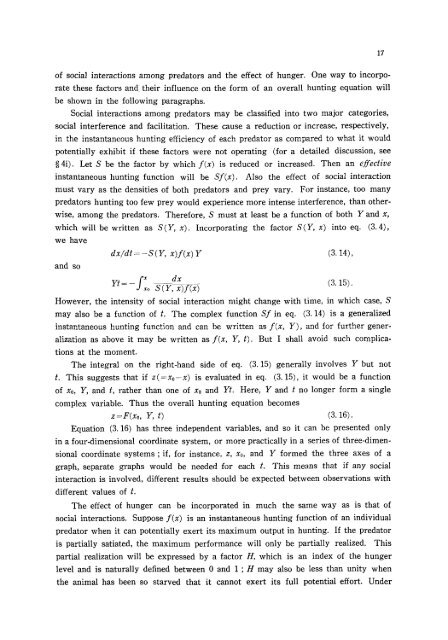A comparative study of models for predation and parasitism
A comparative study of models for predation and parasitism
A comparative study of models for predation and parasitism
Create successful ePaper yourself
Turn your PDF publications into a flip-book with our unique Google optimized e-Paper software.
17<br />
<strong>of</strong> social interactions among predators <strong>and</strong> the effect <strong>of</strong> hunger. One way to incorpo-<br />
rate these factors <strong>and</strong>~ their influence on the <strong>for</strong>m <strong>of</strong> an overall hunting equation will<br />
be shown in the following paragraphs.<br />
Social interactions among predators may be classified into two major categories,<br />
social interference <strong>and</strong> facilitation. These cause a reduction or increase, respectively,<br />
in the instantaneous hunting efficiency <strong>of</strong> each predator as compared to what it would<br />
potentially exhibit if these factors were not operating (<strong>for</strong> a detailed discussion, see<br />
w 4i). Let S be the factor by which f(x) is reduced or increased. Then an effective<br />
instantaneous hunting function will be Sf(x). Also the effect <strong>of</strong> social interaction<br />
must vary as the densities <strong>of</strong> both predators <strong>and</strong> prey vary. For instance, too many<br />
predators hunting too few prey would experience more intense interference, than other-<br />
wise, among the predators. There<strong>for</strong>e, S must at least be a function <strong>of</strong> both Y <strong>and</strong> x,<br />
which will be written as S (Y, x). Incorporating the factor S (Y, x) into eq. (3.4),<br />
we have<br />
<strong>and</strong> so<br />
dx/dt= -S(Y, x)f(x) Y (3. 14),<br />
Yt = _ ~,jx dx (3.15).<br />
xo S (Y, x)f(x)<br />
However, the intensity <strong>of</strong> social interaction might change with time, in which case, S<br />
may also be a function <strong>of</strong> t. The complex function Sf in eq. (3.14) is a generalized<br />
instantaneous hunting function <strong>and</strong> can be written as f(x, Y), <strong>and</strong> <strong>for</strong> further gener-<br />
alization as above it may be written as f(x, Y, t). But I shall avoid such complica-<br />
tions at the moment.<br />
The integral on the right-h<strong>and</strong> side <strong>of</strong> eq. (3.15) generally involves Y but not<br />
t. This suggests that if z(=xo-x) is evaluated in eq. (3. 15), it would be a function<br />
<strong>of</strong> xo, Y, <strong>and</strong> t, rather than one <strong>of</strong> x0 <strong>and</strong> Yr. Here, Y <strong>and</strong> t no longer <strong>for</strong>m a single<br />
complex variable. Thus the overall hunting equation becomes<br />
z =F(x0, Y, t) (3.16).<br />
Equation (3. 16) has three independent variables, <strong>and</strong> so it can be presented only<br />
in a four-dimensional coordinate system, or more practically in a series <strong>of</strong> three-dimen-<br />
sional coordinate systems;if, <strong>for</strong> instance, z, x0, <strong>and</strong> Y <strong>for</strong>med the three axes <strong>of</strong> a<br />
graph, separate graphs would be needed <strong>for</strong> each l. This means that if any social<br />
interaction is involved, different results should be expected between observations with<br />
different values <strong>of</strong> t.<br />
The effect <strong>of</strong> hunger can be incorporated in much the same way as is that <strong>of</strong><br />
social interactions. Suppose f(x) is an instantaneous hunting function <strong>of</strong> an individual<br />
predator when it can potentially exert its maximum output in hunting. If the predator<br />
is partially satiated, the maximum per<strong>for</strong>mance will only be partially realized.<br />
partial realization will be expressed by a factor H, which is an index <strong>of</strong> the hunger<br />
level <strong>and</strong> is naturally defined between 0 <strong>and</strong> 1 ; H may also be less than unity when<br />
the animal has been so starved that it cannot exert its full potential ef<strong>for</strong>t. Under<br />
This















